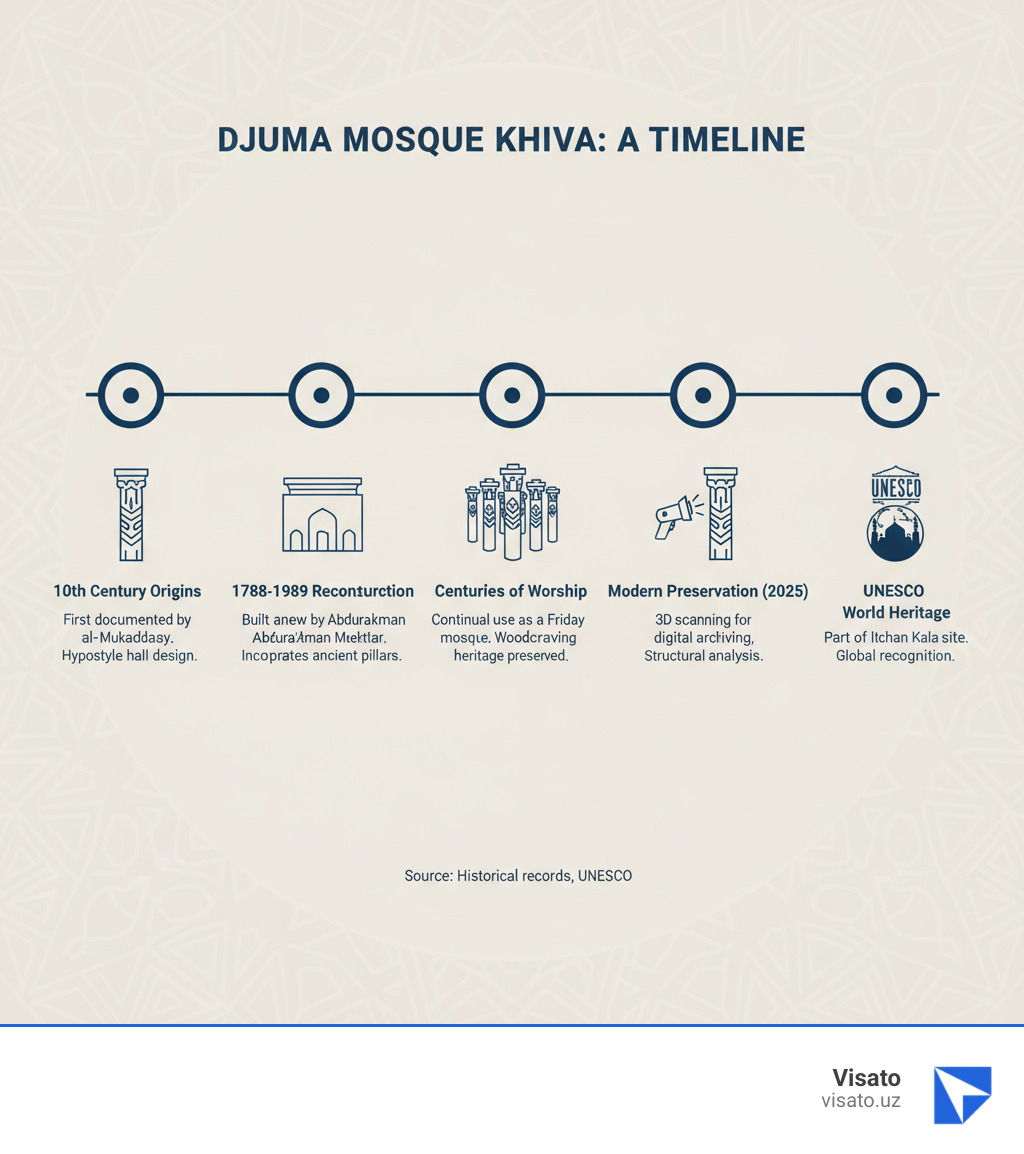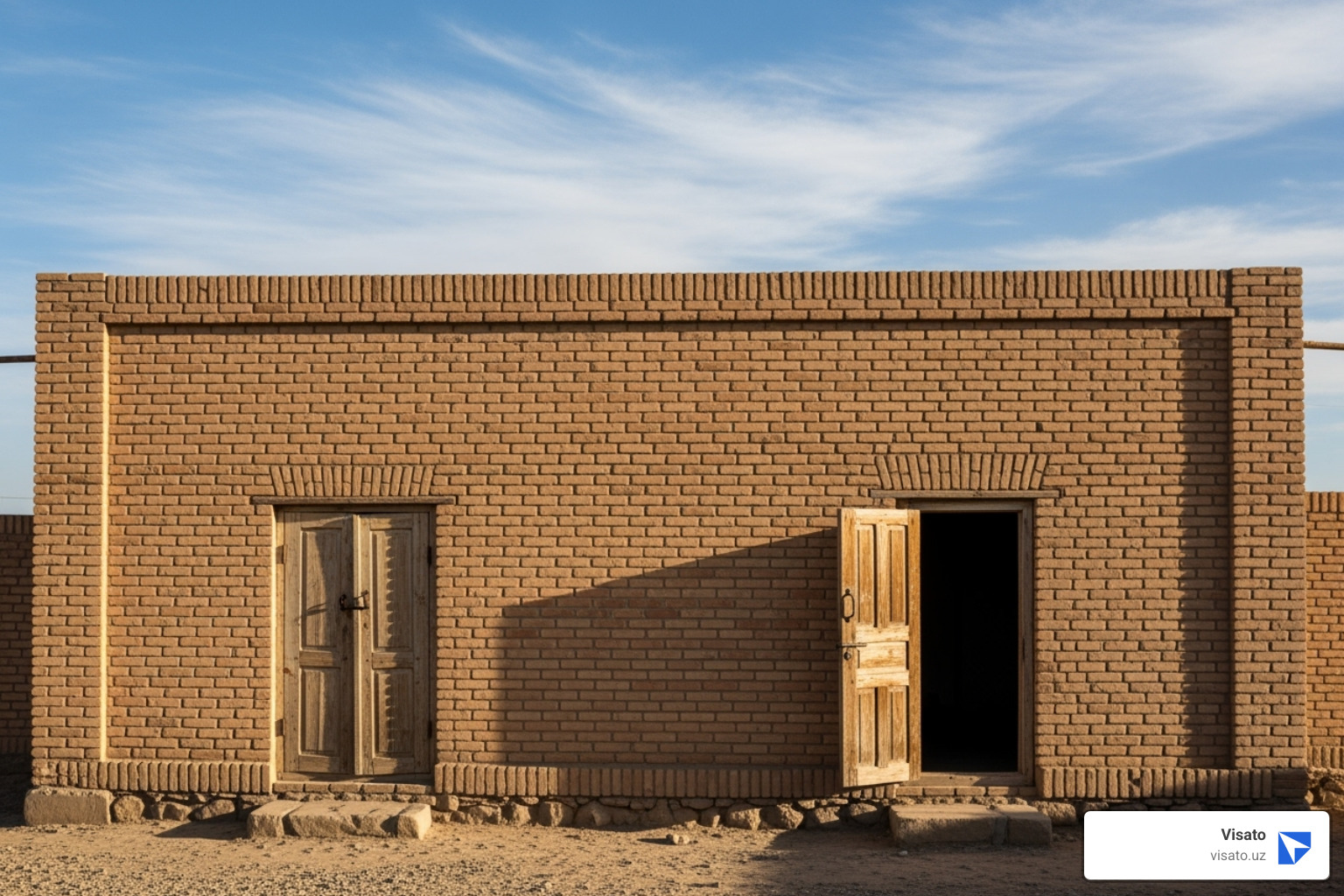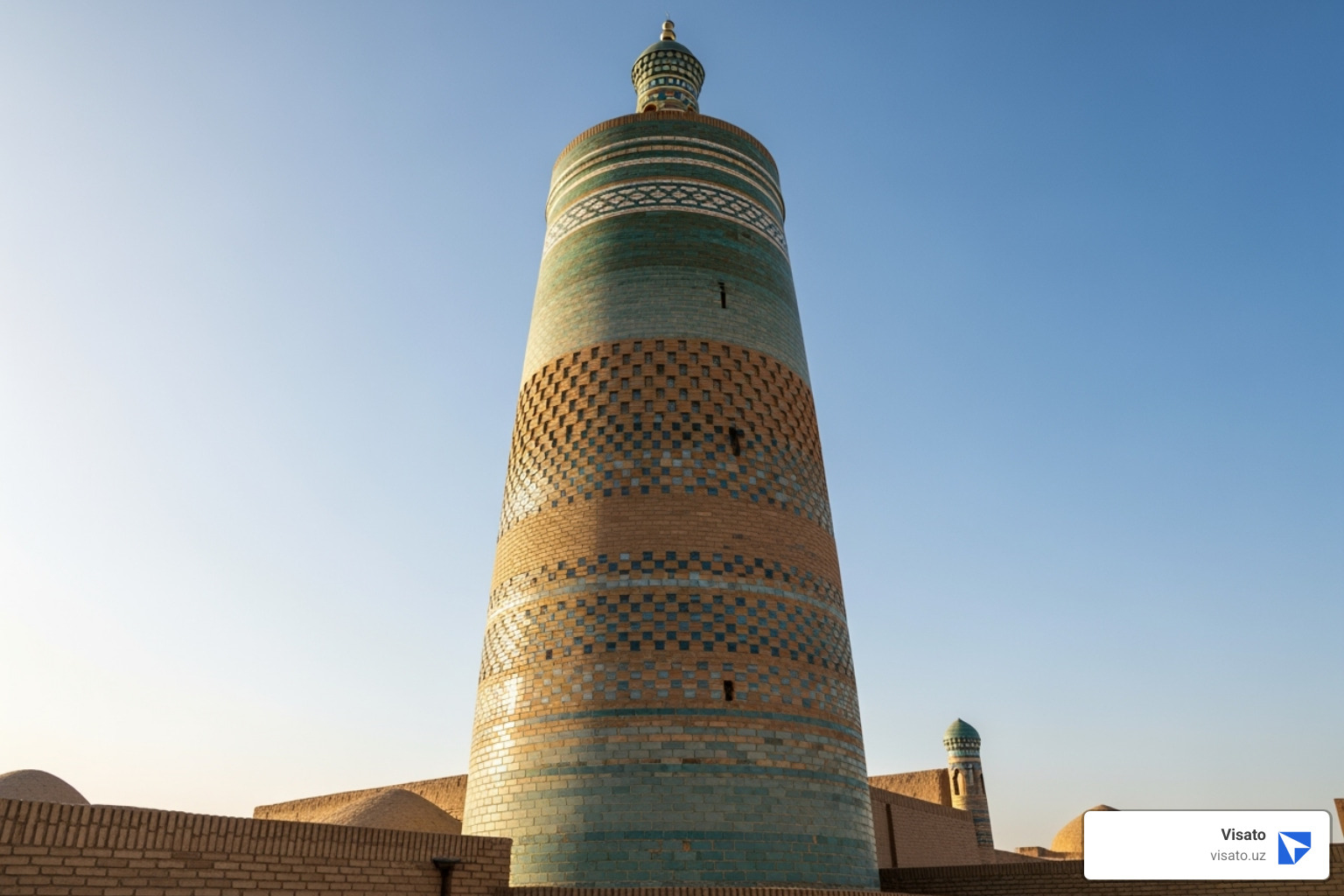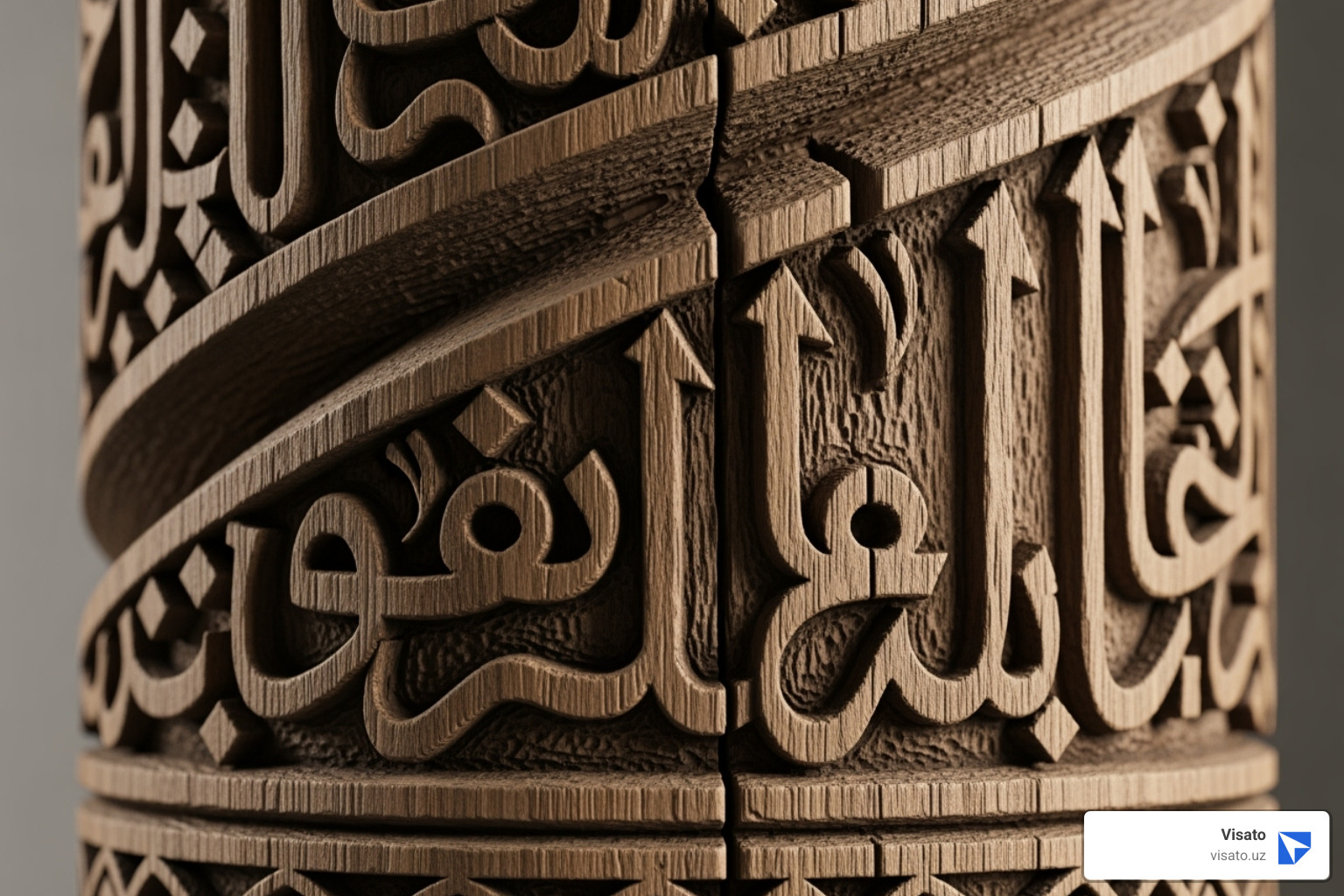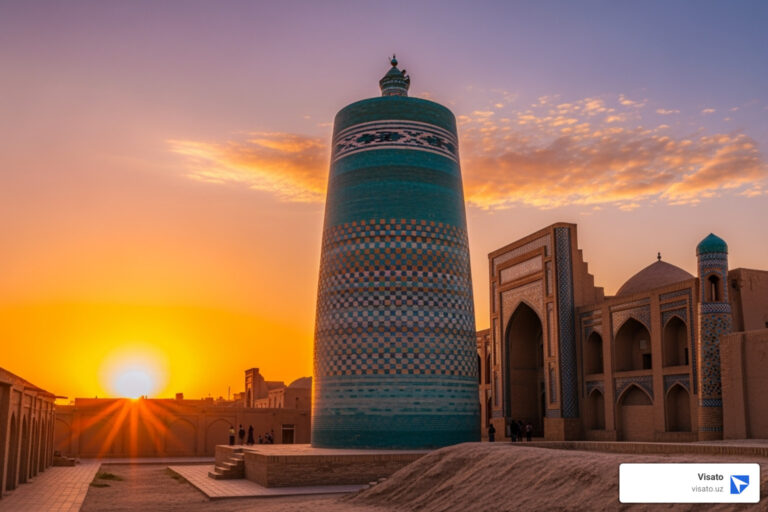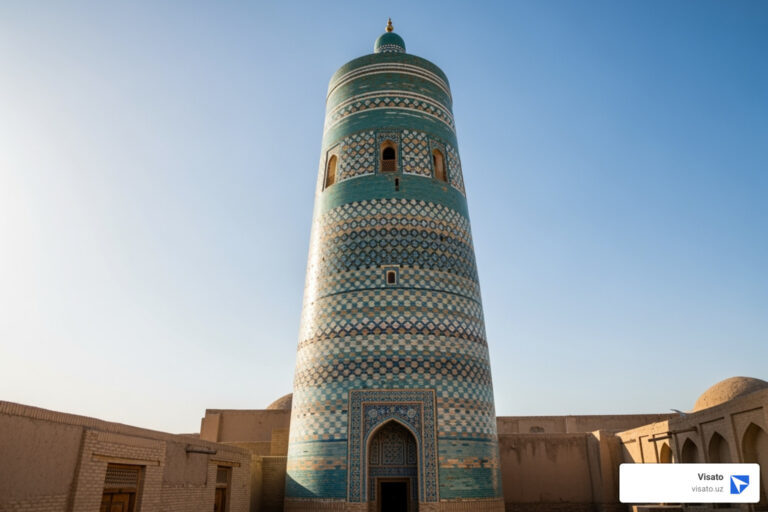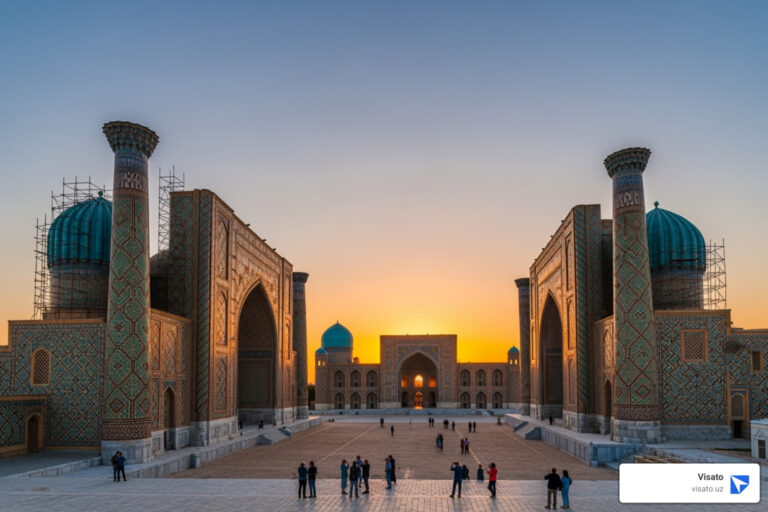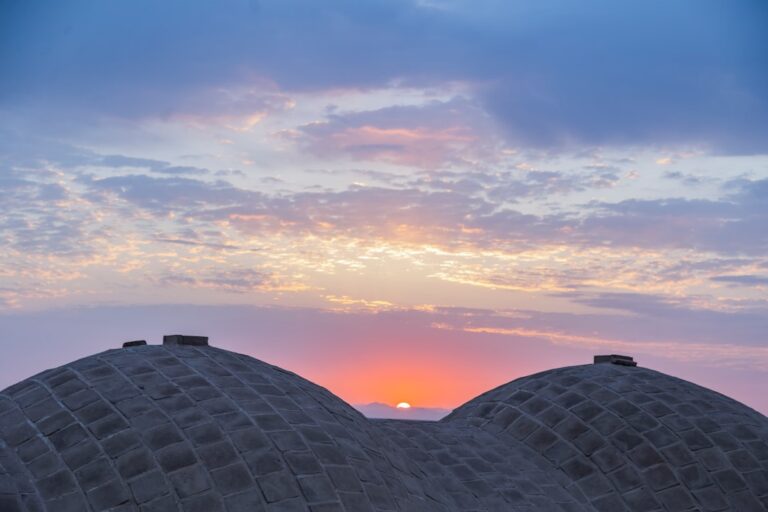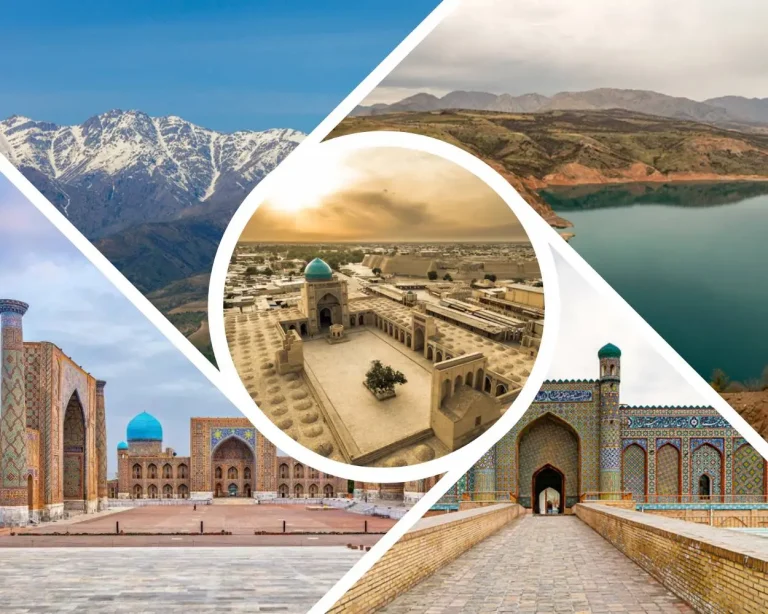A Forest of History in Itchan Kala
Djuma Mosque Khiva is a 10th–18th century mosque located in the heart of Itchan Kala, Khiva’s walled old city and a UNESCO World Heritage Site. Unlike typical Central Asian mosques with grand portals and domes, this Friday mosque features a unique hypostyle hall supported by 212-213 intricately carved wooden pillars arranged in 17 rows across a 55 x 46 meter space.
Key Facts:
- Built: First documented in the 10th century, rebuilt in 1788-1789
- Location: Center of Itchan Kala, Khiva, Uzbekistan
- Architecture: Single-story brick building with flat roof, no courtyards or domes
- Pillars: 212-213 carved karagacha (black elm) columns, 25 dating from 10th-16th centuries
- Minaret: 32.5-42 meters high (sources vary), 81 steps to the top
- Visiting: Included in Itchan Kala ticket, open 09:00-18:00 daily
Walking into the Juma Mosque feels less like entering a place of worship and more like stepping into a forest. Dim light filters through three ceiling openings, casting shadows between the columns. Each pillar tells its own story—some feature ancient Kufic script from the 10th century, others display geometric patterns from the 15th century, and still others show the floral motifs popular in 18th-century Khiva.
What makes this mosque extraordinary isn’t just its age or its location within a World Heritage Site. It’s a living museum of Khorezmian woodcarving, preserving centuries of Central Asian artistic tradition in a single space. Some pillars were brought from the medieval capital of Kath, others were crafted specifically for the 1788 reconstruction, and the oldest four date back over a thousand years.
The mosque’s architecture deliberately breaks from tradition. There are no grand entrance arches, no towering domes, no ornate courtyards—just solid brick walls, a flat ceiling, and that remarkable forest of pillars. This simplicity creates what visitors describe as a “monastic calm” and a “cool, dim, almost subterranean retreat from the bright desert heat.”
I’m Nariman Huseynov, and through my work at Visato helping travelers secure their Uzbekistan e-visas, I’ve guided thousands of visitors to experience sites like Djuma Mosque Khiva firsthand. Understanding the historical and cultural significance of these monuments helps travelers appreciate why Uzbekistan remains one of Central Asia’s most fascinating destinations.
A Journey Through Time: The History of Djuma Mosque Khiva
The story of Djuma Mosque Khiva begins over a thousand years ago. The Arab geographer al-Mukaddasy first documented it in the 10th century as an established place of worship in a thriving Silk Road city. The current building, however, dates from a 1788-1789 reconstruction led by Abdurakhman Mekhtar. This project didn’t erase the past but built upon it, incorporating materials from earlier structures on the same sacred ground. Craftsmen salvaged ancient wooden pillars from ruined buildings, including some from Kath, the old capital of Khorezm. Some of these columns were already centuries old, carved with 10th and 11th-century Kufic script. By combining these with newly carved pillars, the builders created a mosque that is also an unintentional museum of woodcarving. Its location within Itchan Kala, on a main road, reflects its role as the city’s central Friday mosque, a spiritual heart that has served the community for over a millennium.
Architectural Uniqueness in Central Asia
If you’ve visited other mosques in Uzbekistan, the Djuma Mosque Khiva will surprise you. It lacks the typical soaring portals, blue domes, and intricate mosaics. Instead, you’ll find a modest one-story brick building with a flat roof and an unadorned wall.
This architectural restraint is deliberate. While Khiva’s other monuments impress with ornate decoration, the Juma Mosque’s exterior is unassuming. The real magic happens inside. The interior is just as simple, with plain walls and little natural light. As your eyes adjust to the dimness, light from three ceiling openings reveals what looks like a forest of wooden columns stretching into the shadows. Visitors often describe the atmosphere as having a “deep, monastic calm” or feeling like a “cool, dim, almost subterranean retreat.” The limited light creates shifting shadows that improve the contemplative mood. This design—a hypostyle hall—is more common in ancient Arabian mosques. It creates a large, unified prayer space without interior walls, where the absence of courtyards and galleries reinforces a sense of communal unity.
The Minaret: Khiva’s Ancient Watchtower
Rising beside the Djuma Mosque Khiva is its minaret, a slender brick tower. Sources state its height is 32.5 meters to the gallery, or around 42 meters to the top. It has a 6.2-meter diameter at its base, tapering as it rises.
For a small extra fee, you can climb the 81 steps to the gallery. Be warned, the spiral staircase is narrow and the steps uneven, but the effort is worth it. From the top, you get breathtaking panoramic views across all of Itchan Kala—the walled city laid out below with its mud-brick houses, turquoise domes, and winding alleys. The minaret itself is relatively simple, decorated with narrow belts of small turquoise bricks. This restrained style marks it as one of Khiva’s earliest minarets, built during the 1788-1789 reconstruction. Its robust, functional architecture speaks to an earlier era when beauty came from proportion and simplicity.
The Pillars: A Museum of Khorezmian Woodcarving
Step inside the Djuma Mosque Khiva, and you’ll understand why visitors call it a “forest.” But this isn’t just any collection of columns—it’s a living museum of Khorezmian woodcarving that spans nearly a thousand years of artistic tradition.
The mosque shelters between 212 and 213 wooden pillars, each one carved from karagacha wood, known in English as black elm. What makes this collection extraordinary isn’t just its size, but its story. Many of these pillars weren’t created for the 1788 reconstruction at all. They’re spolia—architectural elements salvaged from older buildings, brought here to live a second life.
Some pillars arrived here as trophies of war, carried back from distant battlefields. Others were transported from Kath, the medieval capital of Khoresm, when that ancient city fell into decline. This practice of reusing architectural elements wasn’t just practical—it was a way of honoring the skilled craftsmen of earlier generations and preserving their work for the future.
Among the hundreds of columns, at least 25 are considered ancient treasures, dating from the 10th to the 16th centuries. These older pillars are the crown jewels of the collection, each bearing unique carvings that tell us about the artistic sensibilities of their time. Four pillars are particularly valuable, installed by direct order of the khan himself, bearing witness to over a millennium of history.
Walking through this forest of pillars feels like traveling through time. The architectural feature that makes the Djuma Mosque Khiva so special is that no two columns are exactly alike. Each one represents a different carver, a different era, a different artistic vision. Together, they create an unparalleled archive of Central Asian woodcarving tradition, preserved in the cool, dim interior of this remarkable mosque.
The Unique Pillars of Djuma Mosque Khiva
The 212 to 213 pillars of the Djuma Mosque Khiva stand arranged in 17 orderly rows, spaced about 3.15 meters apart in a perfect grid. But don’t let that geometric precision fool you—each column is a unique masterpiece, carved by different hands across different centuries.
The oldest pillars, from the 10th and 11th centuries, feature deep, archaic carvings and Kufic script. Kufic was an early form of Arabic calligraphy, angular and bold, often used for monumental inscriptions. These ancient columns sometimes bear inscriptions testifying to their origins, possibly from the medieval capital of Kath. When you stand before one of these thousand-year-old pillars, you’re looking at some of the oldest surviving examples of Islamic woodcarving in Central Asia.
As centuries passed, the carving styles evolved. Pillars from the 11th to 14th centuries show more developed Arabic calligraphy alongside intricate geometric patterns. The craftsmen had refined their techniques, creating more complex interlaced designs that demonstrate growing artistic confidence.
By the 15th and 16th centuries, carvers were working in flat relief patterns, sometimes imitating the styles of earlier masters. These columns blend geometric motifs with early floral designs, showing how artistic traditions were being passed down through generations while slowly changing.
The newest pillars, carved during the 18th-century reconstruction, reflect the Khivan floral style popular at that time. You’ll see designs featuring jugs with blooming shoots and other botanical motifs that give these columns a distinctly different character from their ancient neighbors.
This chronological spectrum—from austere Kufic inscriptions to elaborate floral designs—turns the mosque into a textbook of Central Asian art history. You can literally watch the evolution of woodcarving styles as you walk from one column to the next. The fact that these pillars were gathered from different sources, salvaged from earlier structures and brought together in one space, makes the Djuma Mosque Khiva function as something unique: a living archive where the artistic soul of Khorezm has been preserved for over a thousand years.
Digitizing a Masterpiece: 3D Scanning and Preservation
Preserving a thousand-year-old mosque isn’t just about repairing bricks and treating wood anymore. Today, technology is stepping in to safeguard cultural treasures in ways our ancestors never imagined. The Djuma Mosque Khiva, with its forest of intricately carved pillars, has become a fascinating case study in how we can use cutting-edge digital tools to protect history.
The “3D Digital Silk Road” project, led by Lublin University of Technology working alongside Uzbek universities and museums, took on the ambitious task of creating a complete digital twin of the mosque. This wasn’t just about snapping a few photos—it meant capturing every carved detail, every ancient Kufic inscription, and every subtle curve in those 212-213 wooden columns.
The challenges were significant. Imagine trying to scan an incredibly complex space while tourists are walking through, light is constantly changing as it filters through those three ceiling openings, and you’re dealing with geometry that’s anything but simple. Each pillar is unique, each carving different. The team had to work around the mosque’s daily visitor traffic, adapting their scanning methodology to what they called “3DScaMITE”—basically, a smart way to capture massive amounts of data without disrupting people’s visits.
The numbers tell their own story. The final point cloud—essentially a digital map of every surface—contained over 2.1 billion individual points and took up about 55 gigabytes of storage. That’s an enormous amount of data, requiring serious computing power to process. The researchers used high-end workstations with 64-core processors and 512GB of RAM to turn all those scanning points into a usable 3D model.
What struck me as particularly clever was their “capture now, process later” approach. They gathered the highest quality data possible, even knowing they couldn’t immediately process all of it. As technology advanced, what seemed impossible to handle in the field became manageable back in the lab. It’s a bit like taking ultra-high-resolution photos today, knowing that future software will let you do things with them you can’t even imagine yet.
The resulting digital model opens up exciting possibilities. Virtual reality tours could let someone in Tokyo or Toronto walk through the Djuma Mosque Khiva and study those ancient pillars up close without ever leaving home. Researchers can now make precise measurements and analyze carving patterns using AI, comparing styles across centuries without touching the fragile wood. Conservation experts have a perfect baseline to monitor any structural changes or deterioration over time.
Perhaps most importantly, this digital preservation means that even if something were to happen to the physical structure—natural disaster, conflict, or simply the wear of time—we’d have an incredibly detailed record. It’s insurance for cultural heritage, a way of protecting not just the building but the stories and artistry embedded in every carved surface.
Planning Your Visit to the Juma Mosque
If you’re planning a trip to Uzbekistan, the Djuma Mosque Khiva absolutely deserves a spot on your itinerary. This isn’t just another mosque—it’s an architectural wonder that stands apart from everything else you’ll see in Central Asia. And the good news? It’s surprisingly easy to visit once you know the basics.
The mosque sits right in the heart of Itchan Kala, Khiva’s ancient walled city. Once you’re inside those historic walls, you’re essentially in a pedestrian paradise. Everything is within walking distance, and the Juma Mosque is one of the most accessible landmarks. You’ll likely spot its minaret rising above the mud-brick rooftops as you wander through the narrow streets.
Getting to Khiva itself requires a bit more planning. Most international travelers arrive in Tashkent, Uzbekistan’s capital, though you can also fly directly to Urgench, which is the closest airport to Khiva. From Tashkent, you have two main options: take an overnight train to Urgench (a wonderfully atmospheric journey if you enjoy train travel), or catch a domestic flight that gets you there in about an hour and a half. From Urgench, Khiva is just a 30-40 minute taxi or bus ride away.
Before you book those flights, though, let’s talk about visas. Most foreign visitors need a visa to enter Uzbekistan, but don’t let that worry you. The country has acceptd e-visas, making the process much simpler than it used to be. At Visato, we’ve helped thousands of travelers steer the application process, and we can typically get your e-visa sorted in just 2-3 business days. We handle the paperwork, answer your questions, and make sure everything is in order before you travel.
Uzbekistan e-visa requirements
Visiting the Djuma Mosque Khiva: A Practical Guide
Now for the practical details that will help you make the most of your visit to this extraordinary place.
Entry and tickets are straightforward. Your admission to the Djuma Mosque Khiva comes included with the general Itchan Kala entrance ticket, which grants you access to most of the major monuments within the walled city. It’s excellent value considering how much you can see. The opening hours are typically 09:00 to 18:00 daily, though these can shift slightly with the seasons or during religious holidays, so it’s worth confirming locally.
Dress modestly when you visit. We’re talking about covering your shoulders and knees—simple respect for a place that’s both a cultural treasure and an active site of worship. While enforcement isn’t always strict for tourists, dressing appropriately shows consideration for local customs and helps preserve the contemplative atmosphere inside.
Here’s something you won’t want to miss: climbing the minaret. For a small extra fee of around US$2, you can tackle those 81 steps to reach the gallery. Yes, the stairway is narrow and the steps are a bit uneven, but the panoramic views of Itchan Kala from the top are absolutely worth it. Wear comfortable shoes with good grip, and take your time going up and down.
Photography enthusiasts, listen up. The interior of the mosque presents a beautiful challenge. Those three ceiling openings create dramatic shafts of light cutting through the dim interior, casting long shadows between the pillars. Morning light works particularly well, filtering in softly and creating an almost mystical atmosphere. The play of light and shadow is most pronounced in the early hours, before the midday sun gets too harsh. For exterior shots of the minaret and the simple brick facade, you’ll find good light throughout the day, though morning tends to highlight the textures beautifully.
Take your time inside. This isn’t a place to rush through. The cool, dim interior offers a welcome respite from Khiva’s bright desert heat, and the forest of pillars invites slow exploration. Each column tells a different story through its carvings—some whisper of the 10th century, others speak of the 18th. The quiet reverence of the space naturally encourages you to slow down, look closer, and truly absorb the centuries of craftsmanship surrounding you.
If you have questions about the visa process or need help understanding what documents you’ll need, we’re here to help. Our team at Visato provides 24/7 support to make sure your journey to Uzbekistan starts smoothly, long before you step into that forest of ancient pillars.
More info about the Uzbekistan e-visa
Frequently Asked Questions about the Juma Mosque
When travelers start planning their visit to the Djuma Mosque Khiva, a few questions come up time and time again. I’ve answered hundreds of these queries through my work at Visato, so let me share what most people want to know before they visit this remarkable site.
Why is the Juma Mosque in Khiva famous?
The Djuma Mosque Khiva stands out for one breathtaking reason: its extraordinary “forest of pillars.” Unlike the grand domed mosques you’ll find throughout Central Asia—with their towering portals, vibrant tilework, and expansive courtyards—this mosque takes a completely different approach. Step inside, and you’re immediately surrounded by over 200 individually carved wooden columns, each one a unique work of art.
What makes these pillars truly special is their age and diversity. Some date back to the 10th century, making them over a thousand years old. The mosque essentially functions as a living museum of Khorezmian woodcarving, preserving centuries of artistic evolution in a single, atmospheric space. You can trace the development of Central Asian craftsmanship just by walking among the columns, from ancient Kufic script to intricate geometric patterns to delicate floral motifs.
The atmosphere itself contributes to the mosque’s fame. Visitors often describe entering the hall as stepping into a different world—dim light filtering through ceiling openings, shadows dancing between columns, and a profound sense of peace that feels almost monastic. It’s this combination of ancient artistry, architectural uniqueness, and spiritual tranquility that makes the Djuma Mosque Khiva one of the most memorable sites along the ancient Silk Road.
How many pillars are in the Juma Mosque?
The Djuma Mosque Khiva contains 212 to 213 carved wooden pillars—historical sources vary slightly on the exact count. These columns are arranged in 17 rows across the prayer hall, creating that distinctive forest effect that makes the mosque so unforgettable.
Among this impressive collection, approximately 25 pillars are considered ancient, dating from the 10th to the 16th centuries. Four of these are particularly valuable, installed by order of the khan himself. Many of these older columns weren’t originally carved for this mosque at all—they were brought from other structures, including the medieval capital of Kath, and even taken as trophies from battlefields.
What’s remarkable is that each pillar is genuinely unique. No two are exactly alike. They showcase different carving techniques, patterns, and artistic styles from various historical periods. Some feature deep archaic carvings with Kufic script, others display elaborate geometric patterns, and still others show the characteristic Khivan floral designs from the 18th-century reconstruction. This diversity is what transforms the mosque from a simple place of worship into an extraordinary open-air museum of Central Asian woodworking traditions.
Can you climb the minaret at the Juma Mosque?
Yes, and I highly recommend it! For a small additional fee (typically around US$2), you can climb the 81 steps inside the minaret to reach the observation gallery. The climb is manageable for most visitors, though the steps are uneven and the stairway can be narrow, so comfortable shoes are essential.
The minaret stands at 32.5 meters high to the gallery level (some measurements include the decorative top, bringing the total height to 42-47 meters). From the top, you’ll enjoy spectacular panoramic views across the entire Itchan Kala—Khiva’s historic walled city. It’s an incredible vantage point for photography and for truly appreciating the layout of this ancient urban landscape.
The minaret itself is historically significant as one of Khiva’s earliest surviving towers, dating to the 18th-century reconstruction. While it’s less ornate than some of the city’s later minarets, its turquoise brick belts add subtle beauty to the functional design. The climb and the view are absolutely worth the small extra cost—you’ll see the Djuma Mosque Khiva and the entire old city from a perspective that few visitors miss.
Conclusion: Experience Khiva’s Timeless Wonder
Standing among the ancient pillars of the Djuma Mosque Khiva, you’re not just visiting another historic building—you’re stepping into a living archive of Central Asian artistry. This remarkable mosque, with its “forest” of over 200 individually carved columns, offers something truly rare: a chance to touch history spanning more than ten centuries. While other mosques in the region impress with turquoise domes and grand portals, the Juma Mosque captivates through its humble simplicity and the quiet stories carved into each wooden pillar.
What makes this place extraordinary isn’t just its age or its UNESCO World Heritage location within Itchan Kala. It’s the way ancient craftsmanship meets modern preservation efforts. The 3D scanning project ensures that future generations will be able to explore this marvel, even as we work to protect the original. It’s the dim, cool atmosphere that offers respite from the desert heat. It’s the realization that some of these pillars were already centuries old when they were moved here in 1788, carrying with them the artistic traditions of the medieval capital of Kath.
For those of us at Visato who help travelers find Uzbekistan, the Djuma Mosque Khiva represents everything we love about this country—the deep history, the artistic brilliance, and the genuine warmth of a culture that has preserved its treasures for visitors to experience. Whether you climb the 81 steps of the ancient minaret for panoramic views or simply wander among the pillars in meditative silence, this mosque offers an experience you won’t find anywhere else in Central Asia.
We’ve guided thousands of travelers through the visa process, and we know that the anticipation of visiting places like the Juma Mosque is what makes the journey worthwhile. The blend of ancient artistry and architectural uniqueness creates a must-see landmark that stays with you long after you’ve left Khiva’s walled city. Let us handle the paperwork so you can focus on planning which pillars you’ll photograph first and whether you’ll brave those minaret steps for the view.
Your journey to witness this timeless wonder begins with a simple first step. Apply for your Uzbekistan e-visa today and let us help you open up the doors to one of Central Asia’s most captivating destinations.

